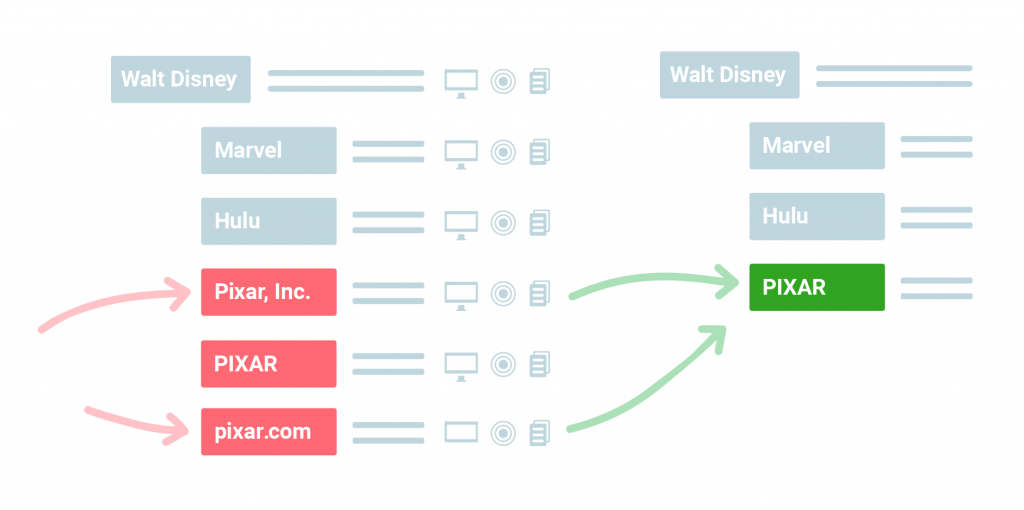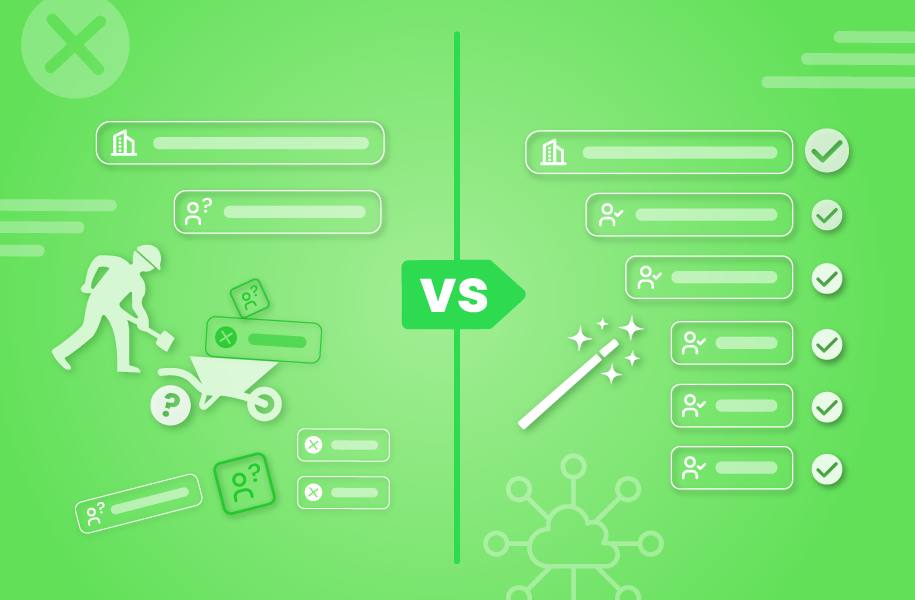Duplicate Data is Costing You
Duplicate data isn’t just annoying – it costs you and your organization time, energy, and revenue.
According to Experian, 94% of organizations lack data accuracy, suspecting that “their customer and prospect data might be inaccurate in some way.”
On top of that, the average company loses 12% of their annual revenue due to dirty data.
Despite this staggering reality, deduplication (or dedupe) projects are often ignored and pushed down the list of priorities – because they’re seen as costly or intimidating.
What companies don’t realize, however, is how duplicate data can negatively impact multiple areas of their business, including:
- Customer experience
- Ability to remain data compliant
- Marketing campaign effectiveness
- Storage costs
The bottom line? Duplicate data isn’t some small problem, it’s a company-wide issue.
In this article, we’re going to cover four reasons it’s time for you to deduplicate your CRM — and some of the signs that a dedupe is overdue. But before we do, let’s explore what exactly duplicates in Salesforce are and where they come from.
What are Duplicates in Salesforce?
Duplicates in Salesforce are records that have been created multiple times but haven’t been merged into a single record. This can include leads, contacts, and even accounts.
Leads are some of the most common duplicates because they can come from multiple sources. For example, imagine if Jen Winters, Sr. Director of Marketing at Acme Inc. visits your booth at a trade show and gets her badge scanned.
Six weeks later, she attends a webinar that your company is hosting – but now she’s been promoted to VP of Marketing. On top of that, when signing up she enters her full name (Jennifer Winters) and used her personal email address. If you don’t have a process in place for managing duplicates your CRM will think these are two different people – when in reality they aren’t.
| Jen Winters | Sr. Director of Marketing | jwinters@acme.com | Source: Tradeshow Booth Visit |
| Jennifer Winters | VP of Marketing | jwinters@hotmail.com | Source: Webinar |
Not only does this create clutter in your CRM but it also creates confusion for sales reps as they try to figure out “who is this person and what do they want?”
Duplicate accounts are a unique challenge because they sometimes lack a unique identifier such as a DUNS number and it can be difficult to know if they are truly a duplicate or if they are a separate location or subsidiary within an account hierarchy.

Where Does Duplicate Data Come From?
There are three main sources which duplicate data can come from.
The first is integrations. Tools outside of your Salesforce org such as marketing automation, ERP, and finance tools can push duplicate data into your system if there isn’t proper data governance in place.
The second is data imports from third-party data sources, mergers and acquisitions between companies, and list uploads from events such as trade shows. This is especially common when an automated Lead-to-Account Matching tool isn’t leveraged.
The final source is Salesforce users and a lack of process. When there isn’t a clear process about when and how to create a new record, sales reps are free to create new accounts, leads, and contacts whenever they want. In other cases, companies worry about blocking incoming data – so they collect everything and end up with too many duplicates to manage.
4 Reasons to Deduplicate Your Salesforce Org
Now that you have a better understanding of where duplicate data comes from, it’s time to look at the payoff. Completing a deduplication project can work wonders for your organization and here’s why.
1. Improving Customer Experience
According to Salesforce, maintaining clean, accurate data is one of the most important things organizations can do to get the most out of their CRM. It means that your sales team can trust their data and that they don’t have to worry about potential conflicts with other sales reps.
Here’s a common scenario – an SDR receives an inbound lead that appears to be a new prospect. They start working on that lead but quickly learn that the person is already in contact with another rep. Or even worse, they’re a longtime customer. Either way, that customer is left with a bad taste in their mouth.
By eliminating duplicates in your CRM you can prevent embarrassing interactions and be confident that leads are routed efficiently and accurately to the right rep.
Did you know? Responding in 5 minutes means you’re 21x times more likely to convert a lead!
2. Reducing the Risk of Anti-Spam Fines
An often overlooked reason to have strong duplicate management is to comply with data protection and privacy regulations such as CCPA, CASL, or GDPR.
If merging is left up to reps, key fields such as “Opt-Out” or “Do No Call” can mistakenly be overwritten. This can result in hefty fines.
It’s important that you are keeping field retention policies in mind when crafting duplicate management processes.
3. Optimizing Marketing Spend and Unlocking ABM
Deduping your CRM also leads to major payoffs for your marketing team – which in turn will drive overall revenue.
Account-based marketing (ABM) is a proven strategy for Revenue Operations teams. The goal of ABM is to narrow down the marketing funnel and focus on high-value accounts while targeting stakeholders, influencers, and decision-makers in the process.
But what happens when Marketing asks sales reps for their target accounts and they’re riddled with duplicates? There’s no clear way to measure touchpoints across the buying journey or the success of the program.
Also, if leads and contacts are duplicated, prospects and customers may receive multiple emails with poorly targeted messaging.
Deduplication can ensure marketing teams have the data they need to make better campaign decisions, target more effectively, and ultimately drive more revenue.
4. Reducing Storage Cost
The last reason to dedupe your CRM is simple. Storage space in Salesforce is expensive and can quickly add up when your duplicates are out of control.
A mass deduplication project can uncover thousands of duplicate records and reduce storage costs drastically. Take, for example, Windstream, which went down from 4 million records down to approximately 500,000.
That’s a whopping 87.5% decrease – think of how much they save on storage costs compared to before!
How to Start Your Deduplication Project
The benefits of undergoing a deduplication project are clear. So the question is, how do you start?
Salesforce has two native functions to help manage duplicates – blocking and alerting.
The first option, alerting, displays a warning message when a user attempts to manually create a record that has a matching field to an existing record, such as a phone number. The drawback here is that alerts are only displayed for manual inserts and can be easily ignored by users.
The second option, blocking, prevents duplicates from entering the CRM when they are created by an API or import. While this is an effective method for exact matches, it can result in losing key data in situations that should otherwise be reviewed.
Organizations that have smaller or newer orgs will be able to rely on Salesforce’s native management tools and use manual merging to maintain a clear database. But what do you do if your organization adds hundreds or thousands of new records daily?
Is it time to look for a data cleansing tool? Do any of these apply to your business?
- Over 10,000 records in Salesforce
- 3 or more ways for records to enter Salesforce (ex. via integrations)
- Afraid of losing data with Salesforce’s blocking method
- Need to match cross-object (ex. Lead to Contact matching)
- Need to automatically process duplicates as they enter (ex. duplicate prevention)
- Need to merge more than 2 records together at a time
Proactive vs. Reactive Deduplication
If you’ve checked off any of the boxes above, your company should consider using an automated data cleansing tool. As far as your options go, there are two strategies to consider.
For a moment, let’s compare data to dental hygiene – a trip to the dentist if you will. In order to keep your teeth (data) healthy, you have to combine reactive and proactive measures.
Reactive would be a trip to the dentist where you get cavities filled, do root canals, or put on braces. In the lens of data, a reactive approach would involve mass deduplication and is recommended when your org has a large number of historical or existing records that require matching and merging.
In this case, third-party apps like Complete Clean can make this process a no-brainer. Users can identify groups of duplicates, create complex match, merge and field retention rules, preview how those rules will impact records, and generate reports to show stakeholders what records were merged – all with no code.
A proactive approach is like remembering to brush and floss your teeth every day – once the dentist has addressed major issues, it prevents major work from being done in the future.
Proactive deduplication addresses records as they enter your CRM. Each time a record is inserted, tools like Complete Leads can utilize rules created during the reactive process to automatically match, merge, and convert records in real time as they enter Salesforce.
Ready to Drop Those Duplicate Records?
No matter how large your database is, it’s important to remember – it’s very possible to overcome duplicate data. It’s just a matter of starting.
Angie Swenson, CRM Business Analyst and Architect at Huber Engineered, for example, has brought her team’s CRM down to less than 2% duplicates, with a mission to get to 1% in 2022.
Looking for more steps to get prepared for your deduplication project?
Download our free Step-by-Step Guide to Deduplicating Your CRM and say goodbye to dirty data for good.




